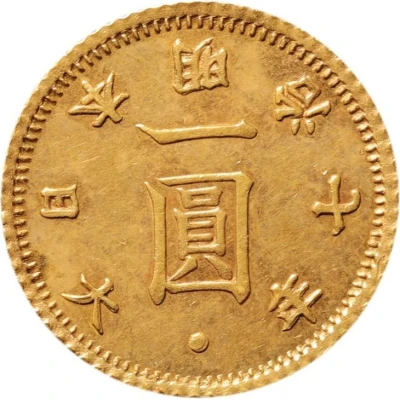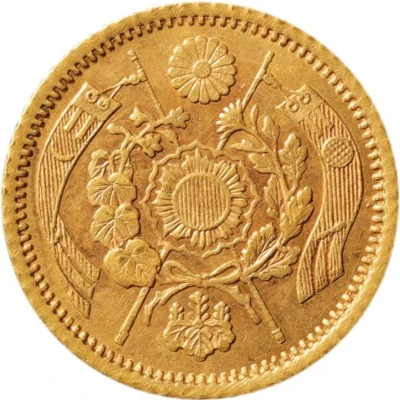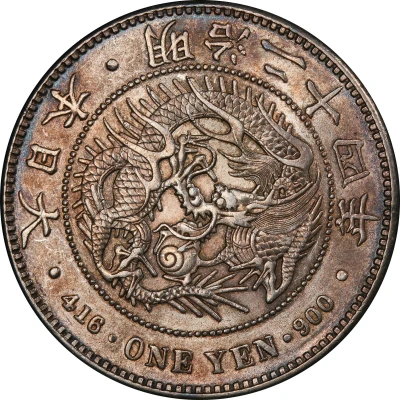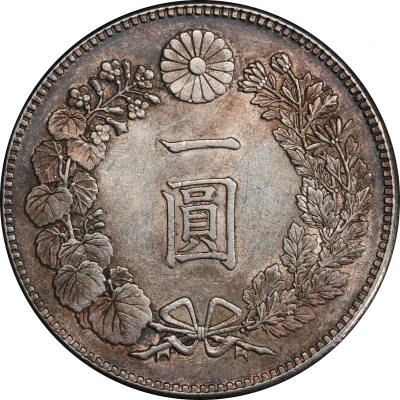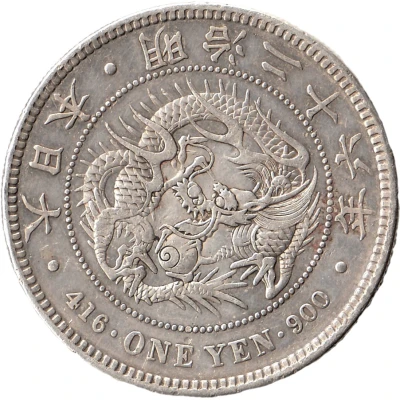
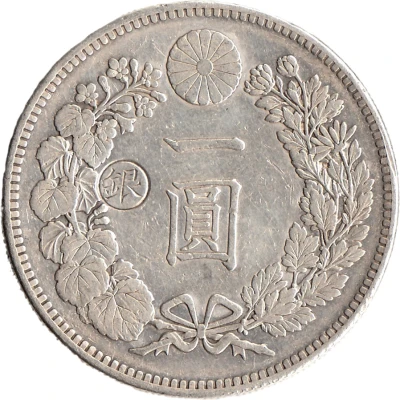

© Christopher Li (CC BY-NC-SA)
1 Yen - Meiji small type - countermarked left
| Silver (.900) | 26.96 g | 38.1 mm |
| Issuer | Japan |
|---|---|
| Emperor | Meiji (1867-1912) |
| Type | Standard circulation coin |
| Years | 20-30 (1887-1897) |
| Calendar | Japanese - Meiji era |
| Value | 1 Yen (1 JPY) |
| Currency | Yen (1871-date) |
| Composition | Silver (.900) |
| Weight | 26.96 g |
| Diameter | 38.1 mm |
| Thickness | 2.76 mm |
| Shape | Round |
| Technique | Milled, Countermarked |
| Orientation | Coin alignment ↑↓ |
| Demonetized | Yes |
| Updated | 2024-10-05 |
| Numista | N#135906 |
|---|---|
| Rarity index | 57% |
Reverse
Chrysanthemum Flower (Coat of Arms & Emperor's Royal Seal)
Branches of Paulownia Flower (Heart shaped leaf) and Chrysanthemum Flower on either side of the value
Counterstamped with on let side of value
Lettering:
銀 一
圓
Translation: Silver 1 Yen
Edge
Reeded
Comment
Note that countermarked version of Y# A25.3 can be only found dated M20 - M30.The diameter of the countermark measured approximately 4.5mm.
Countermark on the left side of the coin indicate that the countermarking was done in Osaka mint.
Close-up of the countermark:
© Christopher Li
Existence of the countermarking due to Japan adopting gold standard in March of Meiji year 30 (1897), which resulted in price drop in silver, enabling oversea merchants exchange for gold from the government, leading to huge outflow of gold and inflow of silver.
By applying countermarks, the silver yen were able to export to Taiwan, Korea and southern Manchuria (in which at that time under Japanese control) for circulation,or sold as bullion in Shanghai or Hong Kong. At the same time, preventing countermarked silver yens returning Japan for further gold exchange.
Such measure enacted October 1897 but cancelled in March the following year due to market confusion.
Interesting fact
One interesting fact about the 1 Yen - Meiji (small type - countermarked left) 20-30 (1887-1897) coin from Japan is that it was minted during a time of significant change and modernization in Japan. The Meiji period, which spanned from 1868 to 1912, saw the country rapidly adopt Western technology and practices, and the introduction of a new currency system was part of this modernization effort. The 1 Yen coin was one of the first coins to be introduced in the new system, and it was designed to replace the traditional Japanese monetary units of the time, such as the ryō and the sen. The coin's design, which features an image of the Imperial crest and the value of the coin in Japanese characters, reflects the blending of traditional Japanese culture with Western influences that characterized the Meiji period.
Price
| Date | Mintage | VG | F | VF | XF | AU | UNC |
|---|---|---|---|---|---|---|---|
| 26 (1893) | - | - | - | - | - | - | |
| 28 (1895) | - | - | - | - | - | - | |
| 29 (1896) | - | - | - | - | - | - |
Values in the table are based on evaluations by sales realized on Internet platforms. They serve as an indication only for 1 Yen - Meiji (small type - countermarked left) 20-30 (1887-1897) coin.
